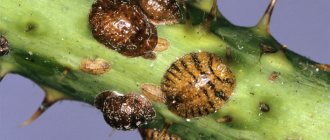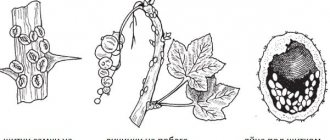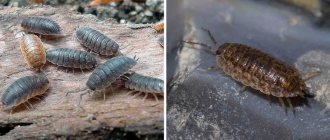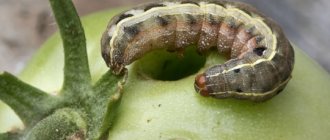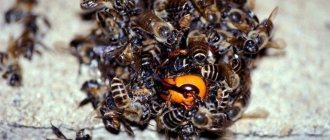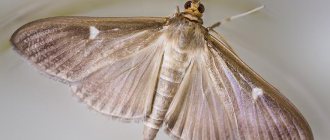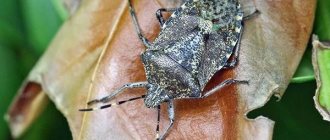Glassworm on currants, how to fight. Pest control
How to get rid of glass from currants? This is not easy to do. The insect leads a secret way of life. The larvae spend their lives inside the stem and are protected from chemical protection by a layer of wood. Destroying this pest takes much more time than fighting other insects.
- When performing autumn sanitary pruning of a currant bush, you must pay attention to the core of the cut branches. If wormholes are noticed inside, then you should study pest control methods and prepare for them next season.
- The fight against glassworm on currants begins with removing the affected branches. Annual branches are pruned down to living core tissue. Old branches must be cut down to the ground. All branches infected with the pest must be burned immediately. And they also cut out all dry and damaged branches, which next year will become a breeding ground for laying eggs.
- If the pest is noticed only at the stage of development inside the stem, then most of the berries on the bush will disappear. If the pest is detected in the spring and the affected branches are cut out, the currant harvest is saved.
- Sometimes you have to cut the entire bush down to the base. But this is the only way to get rid of the larvae living inside the stem.
In the fall, it is worth removing all young branches that have grown less than 15 cm. They are probably already infected with the pest, as the black core will indicate. And it’s also worth checking all the remaining branches. When they are bent, healthy branches spring back, but diseased branches break, because they are empty inside. They are cut out without leaving a stump.
Important! If you systematically cut out infected shoots in spring and autumn, the number of caterpillars will significantly decrease.
How to combat the pest is determined depending on the phase of development, its location and the degree of infection.
Signs of fruit bush infection
In the first year, the branches affected by the glassware are almost impossible to distinguish from a healthy plant, but it can be noted that the leaves and berries begin to shrink. It is for this reason that the pest is difficult to detect in the early stages of its appearance.
Damaged branches begin to actively wither and dry out at the end of flowering or at the moment when berries begin to form (during active feeding of older caterpillars). It is easy to notice these damages only when the leaves begin to bloom the following spring (especially in contrast to healthy plants).
If you start harvesting dry branches, dark holes with black walls are marked on the cuts. By cutting the branch lengthwise, you can see the passage, which is filled with caterpillar excrement, or even the caterpillar itself.
See also
Description of the Emerald Necklace currant variety, its planting and cultivationRead
Anti-glassware drugs. Well-fed and harmful
The greatest damage to large and small farmlands in Russia is caused by three types of glass - apple, currant and raspberry.
A plump body with transverse stripes, small wings, long legs with spurs - this false wasp scares off its enemies not only with its exterior.
The glassfish is a butterfly
The butterfly skillfully copies the flight style of the wasp. The specific appearance and habits allow the glassfish to move calmly during the day.
Like many lepidopteran pests, this wasp-like butterfly is dangerous because of its larvae, which gnaw strange passages in the branches: buds, leaves and fruits wither and die.
The apple glassworm is omnivorous: its caterpillars spoil not only the apple tree, but also quince, hawthorn, plum, apricot, sea buckthorn, cherry, lilac, pear, rowan and birch.
Currant glass “operates” in gooseberries and currants.
Caterpillars calmly tolerate frosts, sitting out in their numerous “tunnels.”
Brown heaps protruding from under the bark will tell you that the tree is affected by glassworm: these are the excrement of the pest, diluted with the sap of the tree.
Like many lepidopteran pests, this wasp-like butterfly is dangerous because of its larvae
You may be interested in an article about folk methods of combating Colorado potato beetles.
Biological methods of control
Experienced gardeners advise peeling off and burning the affected bark in the fall, coating the trunks with manure and clay. In the spring, you need to reapply the mixture in a thick enough layer to block the path of emerging butterflies.
But military actions against the glass beetle are not always doomed to success due to the secret way of life of its larvae.
If you do not want to poison trees with chemicals, use biological preparations:
- “Lepidotsid” - 30 g per bucket of water.
- “Bitoxibacillin” - 100 g per bucket.
- “Fitoverm” - 2 ml per liter of water.
Apple glass
Before planting, currant cuttings can be protected from glassware using the biological agents “Nemabakt” and “Antonem-F” from nematode suspensions.
The cuttings are kept in damp sand with nematodes for at least three days at a temperature of +25 ºС.
When the first buds bloom on the bushes, the currants are treated with Antonem-F at the rate of 200 ml per bush.
glass currant
Arguments in favor of choosing biological products:
- prolonged action;
- high performance;
- safety for humans and nature;
- ease of use.
Raspberry glass
Do not forget also about such an important preventive measure against glass beetle as purchasing seedlings from a seller you trust. Check the planting material carefully.
And during flowering, inspect the bushes and trees, without regret getting rid of branches affected by caterpillars.
Processing terms and rules
It is necessary to spray the bushes when the first leaves appear. This is considered the right time, since during this period caterpillars begin to appear and reside on the surface of the stems. It is during this period that it becomes possible to destroy the glass as effectively as possible.
Currant bushes must be thoroughly sprayed with one or another preparation. So, 1-1.5 liters of solution are spent on each plant.
Glass glass insect. Characteristics of an insect
The glasswort Synanthedon tipuliformis CI belongs to the butterfly family. The insect loves black currants, but sometimes attacks red currants or gooseberries.
Description of appearance
Externally, the pest resembles a small wasp. The wings are narrow with orange stripes along the edges and black streaks. The wingspan is 25-28 cm. The body is oblong, up to 1 cm long, covered with dark gray scales. On the abdomen of females you can see 3 light stripes, and on the male - 4. The insect feeds on plant sap or pollen. This article will tell you about large-fruited tomato varieties for greenhouses.
Life cycle
At the end of May - beginning of June, the butterfly lays 50-60 eggs, each of which is 70 mm long and oblong in shape. For this process, she makes cracks in the bark of a tree-like shoot, certainly next to the young buds.
The greatest danger comes from insect larvae - white or beige caterpillars 2-2.5 cm long with a black head. 10 days after their appearance, they begin to cause harm, eating young shoots from the inside. Caterpillars penetrate deep into the stem, feed, and develop there. Thus, they descend lower and lower to the base of the plant, eating the core.
Before wintering, the length of the passage made by the caterpillar is 15-20 cm. After another year, this size increases to half a meter, and the adult branch dries out completely.
With the arrival of spring, the caterpillar crawls out. From the outside of the branch it pupates and gives birth to the next generation. A new butterfly appears in June, when the air temperature rises above +15°C. The activity of the insect lasts 40-42 days, and the mass period is 10-18 days, ending by the time the fruits ripen.
Find out about the description of the Shalunya cherry variety at this link.
The life cycle of glass is 2 years.
Adult
Glassworts are distinguished by the absence of scales on their wings. This property makes the wings of this garden pest transparent, and the glass cases look like “undressed” butterflies.
The appearance of a small glass butterfly with transparent wings is very similar to a common wasp.
Glassworts, even in their speed of flight, are very reminiscent of wasps. Such mimicry greatly helps glass beetles to scare off numerous predators and makes flight possible during the daytime. Useful mimicry applies only to external data, and does not affect the internal structure at all. The venation of the wings of the glassfish is characteristic of butterflies. These small or medium-sized butterflies have a wingspan of about 1–5 cm. The body of the glassfish is noticeable and thick, and its long legs have large spurs.
Currant pests. Diseases and pests of currants - photos, descriptions, how to treat bushes
Throughout the entire summer season, it is necessary to inspect the plants in the garden in order to detect warning signs in time. Both black and red currants, diseases and pests of which can destroy the entire harvest, require your attention and care.
Black currants (as well as red, white, pink) are subject to the same scourges as gooseberries, so pest and disease control for both crops is essentially the same.
What is wrong with currants?
The plant is able to “signal” that it needs your help, so most diseases can be guessed by changes in the appearance of the bush.
Currants resistant to diseases and pests
To “insure yourself” and protect your plants from most diseases, purchase blackcurrant varieties that are resistant to diseases and pests:
- Zoya;
- Minsk;
- Kipiana;
- Binar;
- Katyusha;
- Primorsky champion;
- Goliath;
- Klussonovskaya;
- Kupalinka;
- Memory of Vavilov;
- Titania;
- Ceres;
- Temptation, etc.
Spheroteka (American powdery mildew)
The causative agent is fungi of the genus Sphaerotheca. The first signs of currant infection with Spheroteka are noticeable already in May: the leaves, stems of the bush, and subsequently the fruits become covered with a white coating (later the color turns brown). Then the berries become smaller and lose their sweetness, diseased bushes do not have time to grow and die. The development of the disease is facilitated by high air humidity and dry, nitrogen-rich soil.
Control measures
The affected parts of the plant must be immediately cut out and burned, and the bushes themselves must be treated with a fungicide (Fundazol, Topaz, etc.). To prevent spheroteca in the fall, it is necessary to remove fallen leaves and thin out bushes. Dusting with wood ash is also effective.
Septoria (white spot)
The causative agent is fungi of the genus Septoria. As with other fungal diseases, the most suitable conditions for the development of white spotting are high humidity, insufficient light, and dense plantings. Brown spots (2-3 mm in diameter) appear on currant leaves, which by mid-summer lighten in the center and turn brown at the edges.
Control measures
Infected leaves and shoots must be removed, then treated with 1% Bordeaux mixture. For prevention, you need to annually prune the bushes, dig up the rows, and remove fallen leaves from the area in the fall.
Anthracnose
Another common fungal disease familiar to many gardeners. The first signs are small reddish spots (diameter 1 mm) on currant leaves, which later begin to darken, swell and expand.
Control measures
In early spring, treatment with 1% Bordeaux mixture will help (repeat after harvesting). Since the fungus overwinters in fallen leaves, in the fall it must be carefully raked out from under the bushes and burned.
Rust
Currants are attacked by 2 types of this disease: goblet (yellow-orange “warts” form on the underside of the leaf) and columnar (characteristic of small reddish spots on the leaves). After some time, the berries and foliage of the diseased bush fall off.
Control measures
When the leaves just begin to bloom, the bushes are treated with a 1% solution of Bordeaux mixture (or other fungicides), then the treatment is repeated during the formation of buds. The final spraying is carried out after flowering.
Reversion (terry)
A viral disease from which the plant cannot be cured. Signs of currant terry: the appearance of the leaves changes - they lengthen and become pointed; later, sterile flowers of irregular shape grow.
Control measures
Diseased bushes will have to be removed from the site; partial pruning of severely affected shoots will not help. To prevent the appearance of this virus, be careful when choosing planting material. Since the terry virus is carried by insects (bud mites, aphids), treat the garden with pesticides in a timely manner.
Striped mosaic
If currant leaves begin to turn yellow ahead of time, most likely a virus has appeared in the garden that causes striped, or veined, mosaic. A characteristic feature - yellowness - spreads along the veins of the leaf, forming a mosaic pattern.
Prevention of infection
In order not to introduce the pest into the garden plot, you need to carefully inspect the planting material. It is forbidden to plant bushes that were found in plant dumps in villages; it is possible that infected plants were taken there.
Before planting, it is better to check the branches for the presence of blackness in the core. The best option is to buy seedlings from trusted nurseries. The soil in the place where it is planned to plant currants is treated with a solution of Trichlorometaphos 3, at a dose of 18-20 g\10 l of water. After planting, mustard powder, crushed wormwood or wood ash are added to the ground around the tree trunk.
In the spring, all bushes can be treated with infusion of citrus fruits and mint; their smell repels the imago of the glass beetle.
After harvesting, the plants are sprayed with a solution of karbofos.
Currant varieties resistant to glassworm damage
Today there are no currant varieties that are completely immune to this pest. However, relatively resistant species include the following:
- Summer resident;
- Natalie;
- Perun;
- Early sweet;
- Vigorous;
- Sechenskaya-2.
These varieties are attacked least frequently by glass, but can still be found on them.
Signs of a pest and damage caused
Since the insect larvae are located inside the stem, in its core, it is difficult to notice them. The presence of a pest can only be determined by external signs on the bush, when the damage has already been done:
- wilting and drying of leaves and shoots above the location of the pest;
- insufficient development of berries;
- change in color of the bark of the shoots, it becomes lighter;
- the presence of pupae on shoots and butterflies on leaves.
If you break the damaged shoot, which, by the way, can be done easily, since the tissues lose their strength, then the black core will be clearly visible. This is a characteristic feature by which currant glass is identified.
The leaves of the bushes on which this pest has settled wither and begin to dry out, nutrition is disrupted, including the ovaries, the fruits develop poorly, become smaller, and taste more sour. Eventually, the plant may die.
Prevention of the appearance of currant glass
It is better to keep any pest at a distance from your site than to fight it later. Therefore, first of all, let's look at measures to prevent damage to currants by glassware.
Before purchasing seedlings or planting cuttings taken from a neighbor, carefully inspect them. All branches of the seedling should be healthy, and the cuttings should not have the slightest sign of a black core. Healthy planting material is not a panacea, of course. No one guarantees that in three or four years the young bush will not be attacked by glassweed. But we still have these three or four years. We still have time to take some preventive measures.
For example, let's plant several elderberry bushes on the plot or next to it. It does an excellent job of repelling glass beetles (and many other pests). And if there is a bird cherry growing nearby, we, on the contrary, will cut it down. The smell of bird cherry is very attractive for glass.
What else can we do? Plant plants with a pungent odor between currant bushes: tomatoes, calendula, nasturtium, garlic, onions, marigolds. The aromas of such “neighbors” are designed to confuse the butterfly. And if she doesn’t detect a currant bush by smell, then she won’t be able to lay eggs.
Reproduction and developmental stages
At the end of April - beginning of May, adult currant glasslets fly out of the holes in the shoots of the plant. The active mating period usually begins at the end of May. The female insects then proceed to lay eggs. Eggs are laid on shoots from one to 10 pieces in one clutch. One female can lay up to 1500 eggs.
After about two weeks, the larvae appear. They penetrate inside young shoots, feeding on their core. In general, caterpillars spend two years inside the plant. After the first winter, they continue to live inside the branches, feeding on their pith and gnawing passages down to the roots of the plant.
After the second wintering, they climb up through their tunnels, and during the swelling of the buds, they gnaw tunnels to the surface in order to turn into pupae during the currant flowering period.
By the beginning of the formation of berries on currants, butterflies fly out of the pupae, whose activity continues until the fruit ripens.
Frequency of procedures
The main activities for processing currant bushes are carried out in spring and autumn. After the butterfly appears, the bushes are sprayed with chemicals 2-3 times with an interval of 10-12 days.
Attention! Treatment should be carried out until the leaves appear and the ovary forms. Chemical treatment is repeated before the start of the winter period.
Treatment with biological products occurs twice during leaf bloom with an interval of two weeks.
Even before the buds begin to bloom, sanitary pruning is carried out. Closer to winter, sanitary pruning of currants is repeated. The sections must be treated with a special paste or garden varnish.
To strengthen the immunity of currants, it is recommended to carry out spring and autumn fertilizing with mineral or organic substances.

